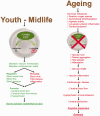Benefits of exercise training on cerebrovascular and cognitive function in ageing
- PMID: 32954902
- PMCID: PMC7907999
- DOI: 10.1177/0271678X20957807
Benefits of exercise training on cerebrovascular and cognitive function in ageing
Abstract
Derangements in cerebrovascular structure and function can impair cognitive performance throughout ageing and in cardiometabolic disease states, thus increasing dementia risk. Modifiable lifestyle factors that cause a decline in cardiometabolic health, such as physical inactivity, exacerbate these changes beyond those that are associated with normal ageing. The purpose of this review was to examine cerebrovascular, cognitive and neuroanatomical adaptations to ageing and the potential benefits of exercise training on these outcomes in adults 50 years or older. We systematically searched for cross-sectional or intervention studies that included exercise (aerobic, resistance or multimodal) and its effect on cerebrovascular function, cognition and neuroanatomical adaptations in this age demographic. The included studies were tabulated and described narratively. Aerobic exercise training was the predominant focus of the studies identified; there were limited studies exploring the effects of resistance exercise training and multimodal training on cerebrovascular function and cognition. Collectively, the evidence indicated that exercise can improve cerebrovascular function, cognition and neuroplasticity through areas of the brain associated with executive function and memory in adults 50 years or older, irrespective of their health status. However, more research is required to ascertain the mechanisms of action.
Keywords: Dementia; ageing; cerebrovascular function; cognition; exercise training.
Conflict of interest statement
Figures


Similar articles
-
Enrichment Effects on Adult Cognitive Development: Can the Functional Capacity of Older Adults Be Preserved and Enhanced?Psychol Sci Public Interest. 2008 Oct;9(1):1-65. doi: 10.1111/j.1539-6053.2009.01034.x. Epub 2008 Oct 1. Psychol Sci Public Interest. 2008. PMID: 26162004
-
Exercise as a Therapeutic Strategy to Improve Cerebrovascular Function and Cognition in Breast Cancer Survivors: A Scoping Review.J Clin Med. 2024 Dec 22;13(24):7841. doi: 10.3390/jcm13247841. J Clin Med. 2024. PMID: 39768764 Free PMC article.
-
The brain-in-motion study: effect of a 6-month aerobic exercise intervention on cerebrovascular regulation and cognitive function in older adults.BMC Geriatr. 2013 Feb 28;13:21. doi: 10.1186/1471-2318-13-21. BMC Geriatr. 2013. PMID: 23448504 Free PMC article.
-
Brain function effects of exercise interventions for cognitive decline: a systematic review and meta-analysis.Front Neurosci. 2023 May 16;17:1127065. doi: 10.3389/fnins.2023.1127065. eCollection 2023. Front Neurosci. 2023. PMID: 37260849 Free PMC article.
-
Potential Indirect Mechanisms of Cognitive Enhancement After Long-Term Resistance Training in Older Adults.Phys Ther. 2020 Jun 23;100(6):907-916. doi: 10.1093/ptj/pzaa013. Phys Ther. 2020. PMID: 31944253 Free PMC article.
Cited by
-
Aerobic physical exercise versus dual-task cognitive walking in cognitive rehabilitation of people with stroke: a randomized clinical trial.Front Psychol. 2023 Oct 13;14:1258262. doi: 10.3389/fpsyg.2023.1258262. eCollection 2023. Front Psychol. 2023. PMID: 37901076 Free PMC article.
-
Exercise MR of Skeletal Muscles, the Heart, and the Brain.J Magn Reson Imaging. 2025 Feb;61(2):535-560. doi: 10.1002/jmri.29445. Epub 2024 May 10. J Magn Reson Imaging. 2025. PMID: 38726984 Free PMC article. Review.
-
Effects of exercise training on cognitive function in community-dwelling older women.BMC Geriatr. 2025 Aug 2;25(1):582. doi: 10.1186/s12877-025-06275-z. BMC Geriatr. 2025. PMID: 40753197 Free PMC article. Clinical Trial.
-
Cerebrovascular Function, Vascular Risk, and Lifestyle Patterns in Resistant Hypertension.J Alzheimers Dis. 2022;87(1):345-357. doi: 10.3233/JAD-215522. J Alzheimers Dis. 2022. PMID: 35275539 Free PMC article.
-
The effect of exercise intensity and cardiorespiratory fitness on the kinetic response of middle cerebral artery blood velocity during exercise in healthy adults.J Appl Physiol (1985). 2022 Jul 1;133(1):214-222. doi: 10.1152/japplphysiol.00862.2021. Epub 2022 Jun 16. J Appl Physiol (1985). 2022. PMID: 35708705 Free PMC article.
References
-
- World Health Organization. Towards a Dementia Plan: A WHO Guide. Geneva: World Health Organization, 2018. https://www.who.int/mental_health/neurology/dementia/policy_guidance/en/.
-
- Toth P, Tarantini S, Csiszar A, et al.. Functional vascular contributions to cognitive impairment and dementia: mechanisms and consequences of cerebral autoregulatory dysfunction, endothelial impairment, and neurovascular uncoupling in aging. Am J Physiol Heart Circ Physiol 2017; 312: H1–H20. - PMC - PubMed

